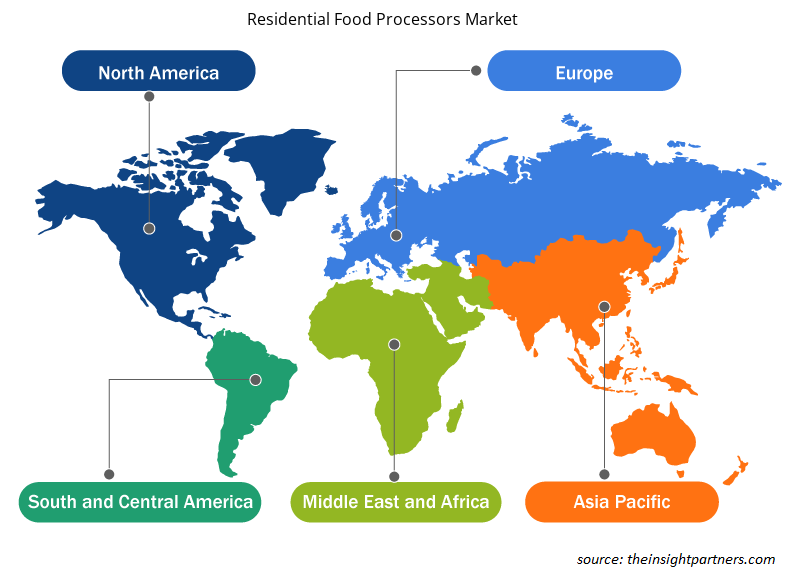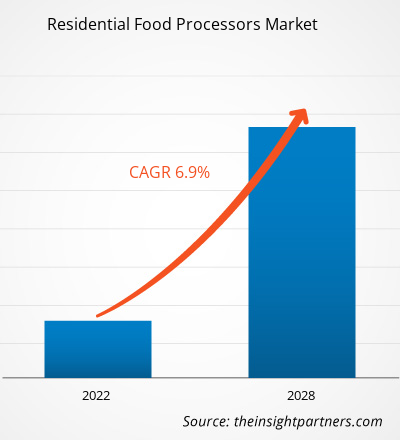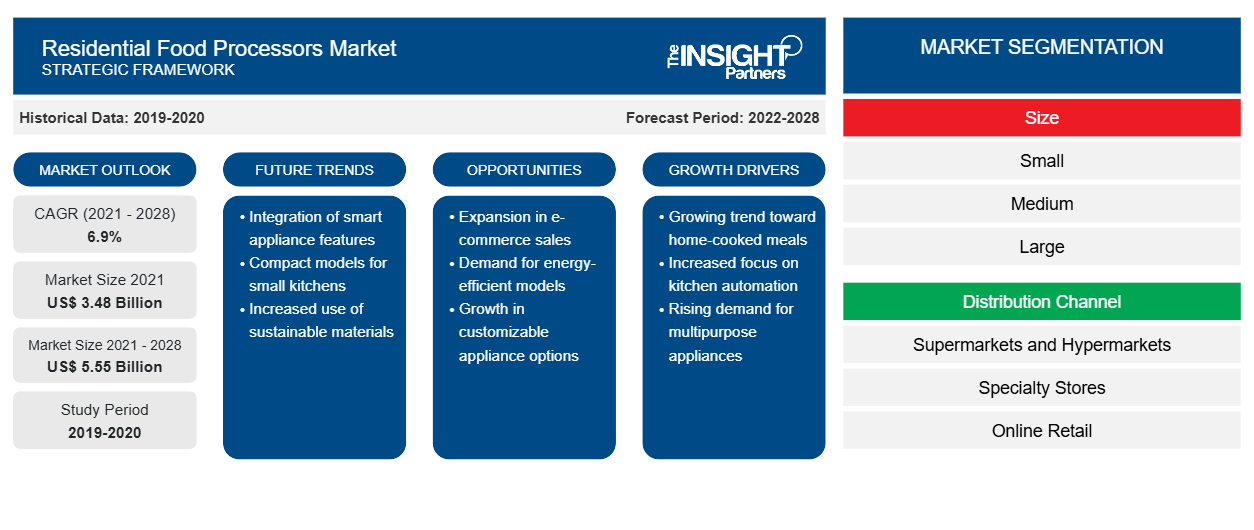Il mercato delle macchine per la lavorazione degli alimenti destinate al consumo domestico è stato valutato a 3.475,21 milioni di dollari nel 2021 e si prevede che raggiungerà i 5.553,20 milioni di dollari entro il 2028; si prevede una crescita a un CAGR del 6,9% dal 2021 al 2028.
Un robot da cucina domestico è fondamentalmente un elettrodomestico da cucina utilizzato per semplificare le attività ripetitive durante la preparazione del cibo. I robot al giorno d'oggi sono per lo più automatizzati e forniscono facilità durante la preparazione del cibo.
Nel 2020, l'Asia Pacifica ha dominato il mercato globale dei robot da cucina residenziali e si prevede che manterrà il suo predominio durante il periodo di previsione. L'aumento della popolazione attiva in tutta la regione ha portato a una domanda crescente di elettrodomestici da cucina e per la casa convenienti . Si prevede che questi fattori stimoleranno la domanda di robot da cucina residenziali in tutta la regione. Inoltre, il cambiamento negli stili di vita dei consumatori ha portato a una maggiore adozione di elettrodomestici da cucina e per la casa modernizzati. L'aumento della popolazione in paesi come Cina e India ha portato a una maggiore costruzione di case e complessi residenziali con spazi cucina limitati. Pertanto, ciò ha portato a una domanda maggiore di piccoli elettrodomestici da cucina, come i mini robot da cucina.
Personalizza questo report in base alle tue esigenze
Riceverai la personalizzazione gratuita di qualsiasi report, comprese parti di questo report, o analisi a livello nazionale, pacchetto dati Excel, oltre a usufruire di grandi offerte e sconti per start-up e università
-
Scopri le principali tendenze di mercato in questo rapporto.Questo campione GRATUITO includerà analisi di dati che spaziano dalle tendenze di mercato alle stime e alle previsioni.
Approfondimenti di mercato
Domanda crescente di prodotti convenienti
Lo stile di vita dei consumatori è diventato frenetico negli ultimi anni a causa della crescente pressione lavorativa, che li fa sentire esausti dopo le normali ore di lavoro. I professionisti che lavorano preferiscono sempre di più elettrodomestici per la casa e la cucina comodi, automatizzati e intelligenti che possono far risparmiare loro tempo e fatica. I robot da cucina residenziali sono multifunzionali e veloci. Questi robot da cucina funzionano in modo efficace e significativo per facilitare il processo di cottura anche se un utente cucina per un gran numero di persone.
Informazioni sulle dimensioni
In base alle dimensioni, il mercato dei robot da cucina residenziali è suddiviso in piccolo, medio e grande. Nel 2020, il segmento medio ha dominato il mercato. La crescente limitazione delle dimensioni e dello spazio della cucina nei paesi in via di sviluppo è uno dei fattori che determinano la domanda di robot da cucina residenziali di medie dimensioni. Il robot da cucina residenziale medio include un disco per affettare medio, un disco per grattugiare e una lama per tritare in acciaio inossidabile per la lavorazione.
Koninklijke Philips NV , Whirlpool Corporation, Breville Group Limited, De'Longhi Appliances Srl , Conair Corporation, Robert Bosch GmbH , MAGIMIX , SharkNinja Operating LLC , Groupe SEB e Spectrum Brands Inc. sono tra i principali attori che operano nel mercato dei robot da cucina residenziali. I principali attori adottano diverse strategie, come fusioni e acquisizioni e lanci di prodotti, per espandere la loro presenza geografica e la base di consumatori.
Approfondimenti regionali sul mercato dei trasformatori alimentari residenziali
Le tendenze regionali e i fattori che influenzano il mercato dei processori alimentari residenziali durante il periodo di previsione sono stati ampiamente spiegati dagli analisti di Insight Partners. Questa sezione discute anche i segmenti e la geografia del mercato dei processori alimentari residenziali in Nord America, Europa, Asia Pacifico, Medio Oriente e Africa e America meridionale e centrale.

- Ottieni i dati specifici regionali per il mercato dei trasformatori alimentari residenziali
Ambito del rapporto di mercato sui trasformatori alimentari residenziali
| Attributo del report | Dettagli |
|---|---|
| Dimensioni del mercato nel 2021 | 3,48 miliardi di dollari USA |
| Dimensioni del mercato entro il 2028 | 5,55 miliardi di dollari USA |
| CAGR globale (2021 - 2028) | 6,9% |
| Dati storici | 2019-2020 |
| Periodo di previsione | 2022-2028 |
| Segmenti coperti |
Per dimensione
|
| Regioni e Paesi coperti |
America del Nord
|
| Leader di mercato e profili aziendali chiave |
|
Densità degli attori del mercato dei trasformatori alimentari residenziali: comprendere il suo impatto sulle dinamiche aziendali
Il mercato dei processori alimentari residenziali sta crescendo rapidamente, spinto dalla crescente domanda degli utenti finali dovuta a fattori quali l'evoluzione delle preferenze dei consumatori, i progressi tecnologici e una maggiore consapevolezza dei vantaggi del prodotto. Con l'aumento della domanda, le aziende stanno ampliando le loro offerte, innovando per soddisfare le esigenze dei consumatori e capitalizzando sulle tendenze emergenti, il che alimenta ulteriormente la crescita del mercato.
La densità degli operatori di mercato si riferisce alla distribuzione di aziende o società che operano in un particolare mercato o settore. Indica quanti concorrenti (operatori di mercato) sono presenti in un dato spazio di mercato in relazione alle sue dimensioni o al valore di mercato totale.
Le principali aziende che operano nel mercato dei trasformatori alimentari residenziali sono:
- Koninklijke Philips NV
- La società Whirlpool
- Gruppo Breville limitato
- Di
Disclaimer : le aziende elencate sopra non sono classificate secondo un ordine particolare.

- Ottieni una panoramica dei principali attori del mercato dei trasformatori alimentari residenziali
Segnala i riflettori
- Tendenze progressive nel settore dei trasformatori alimentari residenziali per aiutare gli operatori a sviluppare strategie efficaci a lungo termine
- Strategie di crescita aziendale adottate dalle aziende per garantire la crescita nei mercati sviluppati e in via di sviluppo
- Analisi quantitativa del mercato globale dei trasformatori alimentari residenziali dal 2019 al 2028
- Stima della domanda di trasformatori alimentari residenziali in vari settori
- Analisi PEST per illustrare l'efficacia degli acquirenti e dei fornitori che operano nel settore per prevedere la crescita del mercato
- Sviluppi recenti per comprendere lo scenario competitivo del mercato e la domanda di trasformatori alimentari residenziali
- Tendenze e prospettive di mercato, insieme ai fattori che guidano e frenano la crescita del mercato dei trasformatori alimentari residenziali
- Comprensione delle strategie che sostengono l'interesse commerciale in relazione alla crescita del mercato globale dei trasformatori alimentari residenziali, aiutando nel processo decisionale
- Dimensioni del mercato dei trasformatori alimentari residenziali in vari nodi di mercato
- Panoramica dettagliata e segmentazione del mercato globale dei trasformatori alimentari residenziali nonché delle dinamiche del settore
- Dimensioni del mercato dei trasformatori alimentari residenziali in varie regioni con promettenti opportunità di crescita
"Global Residential Food Processors Market Analysis to 2028" è uno studio specializzato e approfondito del settore dei beni di consumo con un'attenzione particolare all'analisi delle tendenze del mercato globale dei trasformatori alimentari residenziali. Il rapporto mira a fornire una panoramica del mercato con una segmentazione dettagliata del mercato. Il mercato dei trasformatori alimentari residenziali è segmentato in base a dimensioni, canale di distribuzione e geografia. In base alle dimensioni, il mercato è segmentato in piccolo, medio e grande. In base al canale di distribuzione, il mercato dei trasformatori alimentari residenziali è segmentato in supermercati e ipermercati, negozi specializzati, vendita al dettaglio online e altri. In base alla geografia, il mercato è segmentato in cinque regioni principali: Nord America, Europa, Asia Pacifico, Medio Oriente e Africa e Sud e Centro America.
Profili aziendali
- Koninklijke Philips NV
- La società Whirlpool
- Gruppo Breville Limited
- De'Longhi Elettrodomestici Srl
- Società Conair
- Bosch Italia S.p.A.
- MAGIMIX
- Società operativa SharkNinja LLC
- Gruppo SEB
- Marchio Spectrum Inc.
- Analisi storica (2 anni), anno base, previsione (7 anni) con CAGR
- Analisi PEST e SWOT
- Valore/volume delle dimensioni del mercato - Globale, Regionale, Nazionale
- Industria e panorama competitivo
- Set di dati Excel
Report recenti
Rapporti correlati
Testimonianze
Motivo dell'acquisto
- Processo decisionale informato
- Comprensione delle dinamiche di mercato
- Analisi competitiva
- Analisi dei clienti
- Previsioni di mercato
- Mitigazione del rischio
- Pianificazione strategica
- Giustificazione degli investimenti
- Identificazione dei mercati emergenti
- Miglioramento delle strategie di marketing
- Aumento dell'efficienza operativa
- Allineamento alle tendenze normative























 Ottieni un campione gratuito per - Mercato dei trasformatori alimentari residenziali
Ottieni un campione gratuito per - Mercato dei trasformatori alimentari residenziali